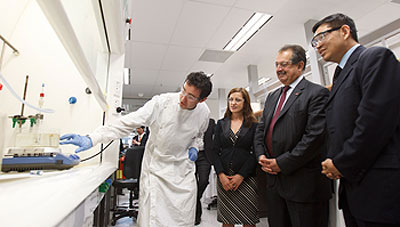| Nov 23, 2010 |
University of Queensland and Dow Chemical announce nanotechnology research collaboration
|
|
(Nanowerk News) The Dow Chemical Company and University of Queensland (UQ)'s Australian Institute for Bioengineering Nanotechnology (AIBN) yesterday signed a Memorandum of Understanding (MOU) for their second research alliance.
|
|
Dow will contribute approximately $AU1.74million in the three-year alliance, allowing AIBN to conduct research on sustainable sources for chemicals, new-generation circuitry for electronics and improved energy storage systems.
|
|
The MOU provides a framework for AIBN and Dow to focus on research with potential commercial value.
|
|
"Innovation is one of Dow's growth drivers and we have an aggressive pipeline of more than 500 projects with a potential value of $US30 billion and a risk-adjusted value of $US12 billion," said Andrew Liveris, Chairman and CEO of Dow.
|
 |
| PhD student Sean Muir, AIBN's Dr Denisa Jurcakova, Dow chairman and CEO Andrew Liveris and Professor Max Lu.
|
|
"Collaboration with world-class research institutes such as the AIBN extends our innovation potential while providing access to top R&D talent."
|
|
AIBN Director Professor Peter Gray said the institute had world-leading researchers, advanced capabilities and a strong record of industrial collaboration, which ensured the collaboration with Dow was a good fit.
|
|
"Our internationally-recognized researchers are at the forefront of emerging technologies. Their focus is on finding solutions to real-world problems," he said.
|
|
"They appreciate the importance of challenging tradition and convention so discoveries are possible and our future brings new possibilities for a better lifestyle and a cleaner world."
|
|
Dow and AIBN's first research collaboration was signed three years ago in 2007 in the areas of bio-mimicry and a systems biotechnology approach to improving productivity and decreasing cost of natural pesticides.
|
|
About the research
|
|
Research into high performance cathode materials based on low-cost nanocarbons will involve the research group led by Professor Max Lu and Dr. Denisa Jurcakova. The objective of the project is to develop improved cathode materials with high energy and power densities for applications in hybrid vehicles and renewable energy storage systems. Concerns over climate change and high oil prices have led to an ever increasing interest in sustainable energy development, such as renewable energy production from solar and wind sources, and the development of hybrid and electric vehicles with low carbon dioxide emissions. Successful development of renewable energy systems requires a combination of efficient production, coupled with effective energy storage systems with high capacity, for when the sun doesn't shine, the wind doesn't blow, or when an electric vehicle needs to accelerate rapidly or have a decent driving range.
|
|
Research in the project will be applicable to the development of the next generation of cathodes materials, and will involve novel material design, synthesis, electrochemistry and fundamental chemistry. The improved nanoparticles developed will find use in batteries with potential use not only in portable devices, but for hybrid vehicles and energy storage for renewable resources such as sun and wind.
|
|
Research into new-generation circuitry for electronics will be completed by Professor Andrew Whittaker's and Dr. Idriss Blakey's research group. Researchers will use organic synthesis, physical chemistry and electrical engineering to craft functional plastics and polymers for the manufacture of integrated circuits. The new generation of circuits will increase performance, decrease size and cost and have potential uses in computers, cameras, smart phones, hand-held gadgets and even fridges.
|
|
Escalating oil costs and concerns about carbon dioxide emissions make it imperative to develop new manufacturing processes based on renewable substrates rather than diminishing fossil fuels. Research carried out in the third project will be led by Professor Lars Nielsen and Dr. Jens Kromer, and will use scientific advances in the biosciences to genetically reprogram bacteria to produce the chemical building blocks of the future.
|
|
AIBN's research excellence in synthetic biotechnology, and in the modeling and optimization of microbial metabolism, as well as polymer chemistry structure and function, make an ideal fit with Dow's position at the forefront of sustainable chemistries.
|
|
The alliance is ultimately expected to deliver new materials and processes capable of producing desired molecules from renewable agricultural resources in a cost effective manner, achieving long-term benefits for the consumer.
|
|
About Dow
|
|
Dow combines the power of science and technology with the "Human Element" to passionately innovate what is essential to human progress. The Company connects chemistry and innovation with the principles of sustainability to help address many of the world's most challenging problems such as the need for clean water, renewable energy generation and conservation, and increasing agricultural productivity. Dow's diversified industry-leading portfolio of specialty chemical, advanced materials, agrosciences and plastics businesses deliver a broad range of technology-based products and solutions to customers in approximately 160 countries and in high growth sectors such as electronics, water, energy, coatings and agriculture. In 2009, Dow had annual sales of $US45 billion and employed approximately 52,000 people worldwide. The Company's more than 5,000 products are manufactured at 214 sites in 37 countries across the globe. References to "Dow" or the "Company" mean The Dow Chemical Company and its consolidated subsidiaries unless otherwise expressly noted. More information about Dow can be found at www.dow.com.
|
|
About The Australian Institute for Bioengineering and Nanotechnology
|
|
AIBN, at The University of Queensland, is home to world leading research at the intersection of biology, chemistry, engineering and computer modeling. It has more than 360 researchers housed in a new, $AU75 million state-of-the-art building complimented by an extensive suite of facilities. This critical mass of researchers is working to develop new products and processes which will significantly impact human health, the environment, and the development of sustainable renewable energy.
|

